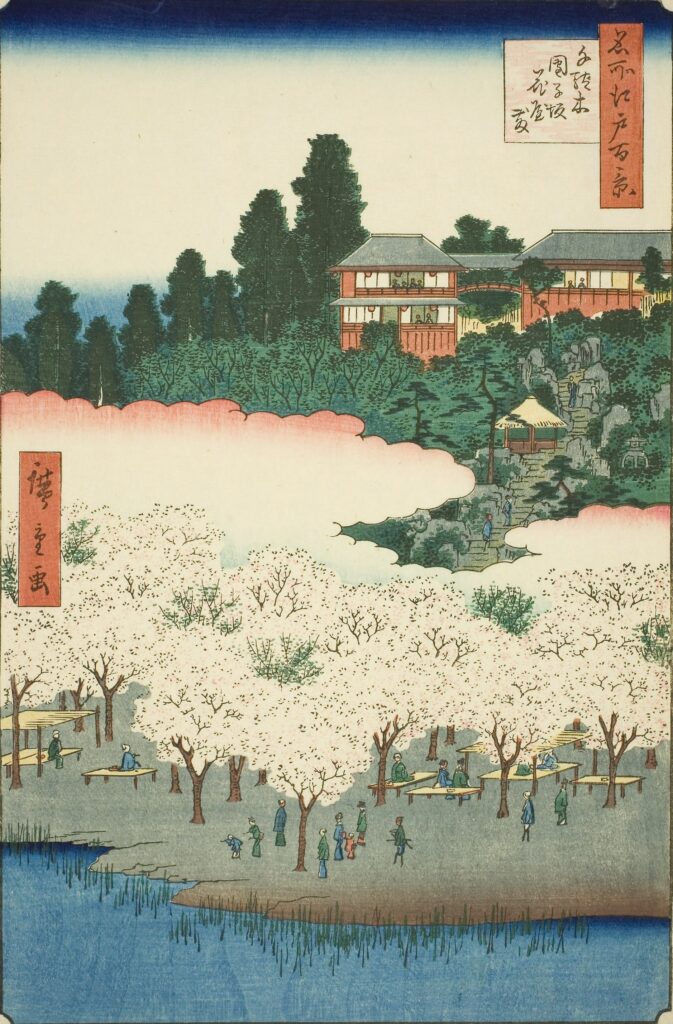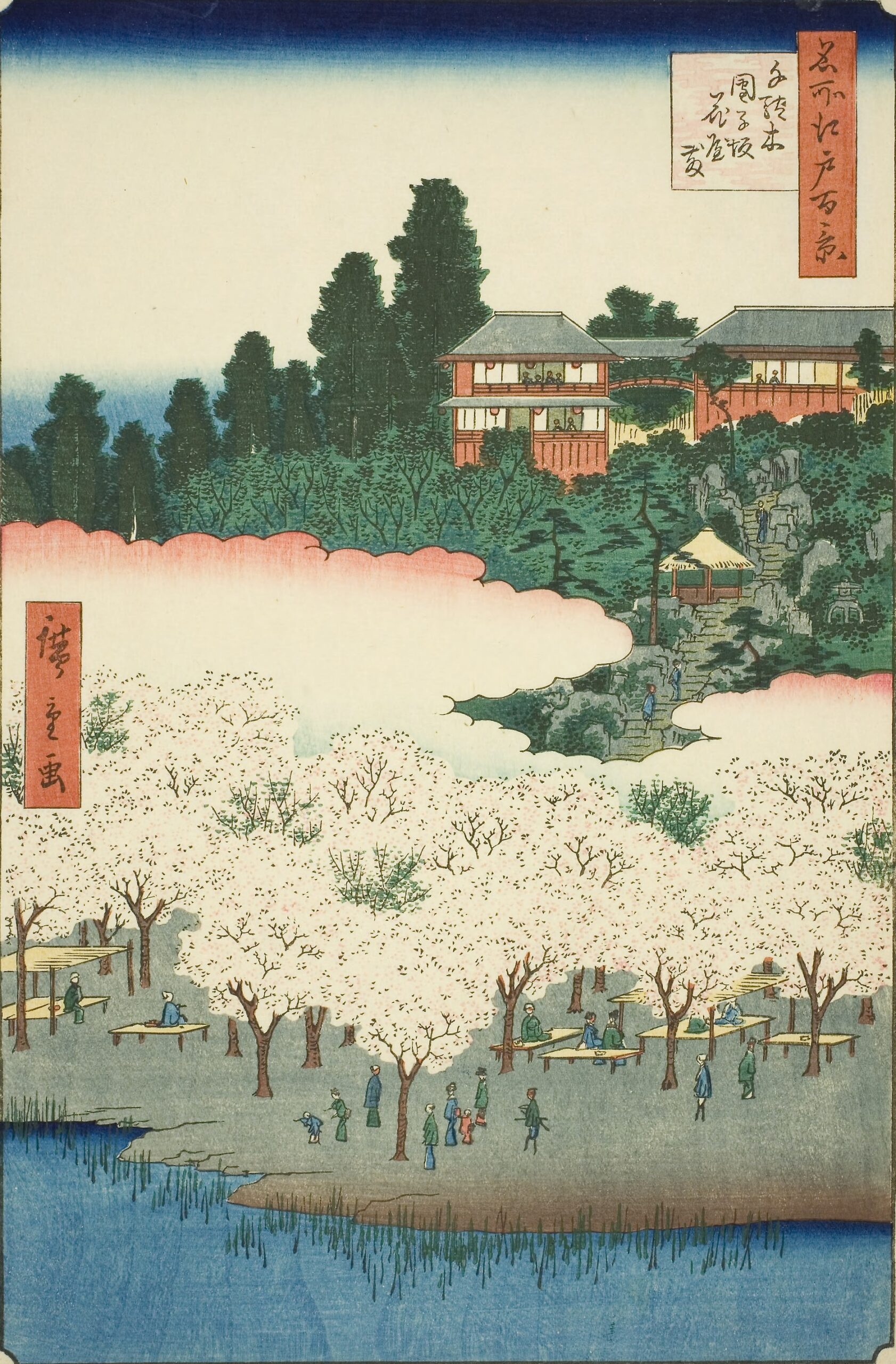
Utagawa Hiroshige – One Hundred Famous Views of Edo – 16 – Spring – Sendagi Dangozaka Flower House – Commentary 歌川広重-名所江戸百景-16-春-千駄木團子坂花屋敷 解説
Current Address: Sendagi 2-chome, Bunkyo Ward (Dangozaka Street; the former flower house site is near the current Nippon Medical School)
Latitude and Longitude: Latitude 35.7258, Longitude 139.7622
Published: May 1856 Age: 60
Commentary
<1> Introduction
“Sendagi Dangozaka Flower House” is popular for its vivid portrayal of Edo’s downtown atmosphere and leisure culture.
Sendagi is an area in what is now Bunkyo Ward, and as part of the Yanesen area, it remains beloved by many people today.
The work depicts the bustling teahouses and flower houses that gave Dangozaka (Dangozaka) its name, making it an essential work for understanding the leisure culture of the Edo commoners.
<2> Dangozaka and Hanayashiki
This slope stretches from present-day Sendagi 2-Chome to 3-Chome. During the Edo period, it was lined with many teahouses and known for serving their specialty, dango (rice dumplings).
It was always a bustling place, with people stopping by on their strolls or while visiting temples and shrines.
The area around the slope was home to flower gardens and restaurants, known as “hanayashiki.”
The gardens, where visitors could enjoy seasonal flowers such as plum, cherry, and peonies, were truly a “little paradise” for the common people of Edo.
Sendagi is close to Ueno and Yanaka, and is home to many temples and shrines, so it was located on walking routes.
As such, it was a perfect stop for sightseeing visitors.
<3> Highlights of the painting
The center of the painting depicts people walking up and down the slope.
The painting vividly depicts a scene from everyday Edo life, with townspeople shopping, leisure travelers admiring the flowers, and children eating dango (rice dumplings).
The teahouse that gave Dango-zaka its name served its famous dumplings.
For the common people of Edo, dipping fragrantly roasted dumplings in a sweet and spicy sauce and enjoying the view was the ultimate luxury.
In the background, the flowers blooming in the gardens of the Hanayashiki add a touch of color.
Hiroshige’s skillful expressiveness is on full display in his depiction of the changing seasons, with cherry blossoms in spring and irises and peonies in early summer.
From the top of the hill, the Edo townscape spreads out in the distance, and the sky offers a sense of expansiveness.
The composition, which combines the entertainment of the common people with the scenery of the great city of Edo, is the allure unique to famous places paintings.
The picture plane is divided into upper and lower halves by clouds.
Dangozaka is located off-screen to the right, and would descend from back to front at a slope similar to the stairs in the painting.
Instead, the upper part of the image shows Shisentei, the flower garden of former gardener Kusuda Uheiji, located south of the slope.
Shisentei was an unusual three-story building, and it seems that people could also bathe inside.
<4> Dangozaka Flower Gardens for the Edo Commoners
Rather than being an expensive form of entertainment, it was popular as an affordable way to enjoy rice dumplings and flowers.
It is said that families and friends often visited.
There were many temples and shrines in the Yanaka and Sendagi areas, and it was common to enjoy a combination of pilgrimages and cherry blossom viewing.
Cultural enjoyment was also popular, with people composing haiku while enjoying rice dumplings at a teahouse or painting pictures with flowers as the subject.
<5> Modern-day “Dangozaka” and the remains of the flower garden
The place name “Dangozaka” and the slope remain in Sendagi today.
The slope is somewhat steep, evoking a glimpse of the area’s past.
Although the former flower estates are gone, the surrounding area is dotted with garden-style temples and green spaces, allowing visitors to imagine the “flower viewing culture of Edo.”
Today, it’s included in tourist courses along with Yanaka Ginza Shopping Street and Nezu Shrine, and the name Dangozaka is also used for cafes and Japanese confectionery shops.
<6> Tourist Guide
1. Strolling Dangozaka
Imagine the bustling teahouses of the past as you walk along the slope.
2. Eating out in Yanaka Ginza
Enjoy the Edo-period dango atmosphere at modern-day restaurants in the shopping district.
3. Nezu Shrine and Yanaka Cemetery
We recommend combining a visit to historic temples and shrines with a visit to Dangozaka.
4. Literary Stroll
Sendagi is also home to many literary figures, including Natsume Soseki and Mori Ogai.
Enjoy a stroll through the area while immersing yourself in the culture.

